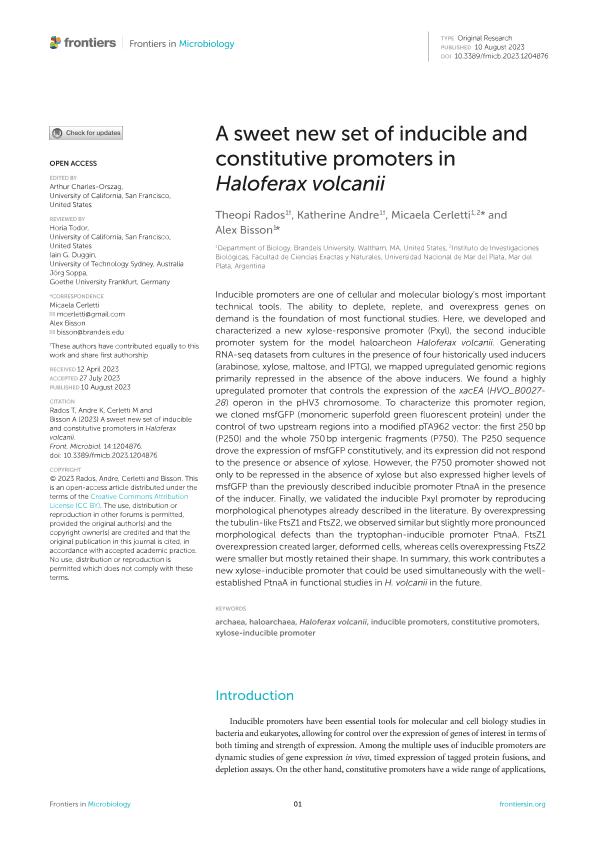Mostrar el registro sencillo del ítem
dc.contributor.author
Rados, Theopi
dc.contributor.author
Andre, Katherine
dc.contributor.author
Cerletti, Micaela

dc.contributor.author
Bisson, Alex
dc.date.available
2023-11-03T17:49:09Z
dc.date.issued
2023-08
dc.identifier.citation
Rados, Theopi; Andre, Katherine; Cerletti, Micaela; Bisson, Alex; A sweet new set of inducible and constitutive promoters in Haloferax volcanii; Frontiers Media; Frontiers in Microbiology; 14; 8-2023; 1-9
dc.identifier.uri
http://hdl.handle.net/11336/216989
dc.description.abstract
Inducible promoters are one of cellular and molecular biology’s most important technical tools. The ability to deplete, replete, and overexpress genes on demand is the foundation of most functional studies. Here, we developed and characterized a new xylose-responsive promoter (Pxyl), the second inducible promoter system for the model haloarcheon Haloferax volcanii. Generating RNA-seq datasets from cultures in the presence of four historically used inducers (arabinose, xylose, maltose, and IPTG), we mapped upregulated genomic regions primarily repressed in the absence of the above inducers. We found a highly upregulated promoter that controls the expression of the xacEA (HVO_B0027-28) operon in the pHV3 chromosome. To characterize this promoter region, we cloned msfGFP (monomeric superfold green fluorescent protein) under the control of two upstream regions into a modified pTA962 vector: the first 250 bp (P250) and the whole 750 bp intergenic fragments (P750). The P250 sequence drove the expression of msfGFP constitutively, and its expression did not respond to the presence or absence of xylose. However, the P750 promoter showed not only to be repressed in the absence of xylose but also expressed higher levels of msfGFP than the previously described inducible promoter PtnaA in the presence of the inducer. Finally, we validated the inducible Pxyl promoter by reproducing morphological phenotypes already described in the literature. By overexpressing the tubulin-like FtsZ1 and FtsZ2, we observed similar but slightly more pronounced morphological defects than the tryptophan-inducible promoter PtnaA. FtsZ1 overexpression created larger, deformed cells, whereas cells overexpressing FtsZ2 were smaller but mostly retained their shape. In summary, this work contributes a new xylose-inducible promoter that could be used simultaneously with the well-established PtnaA in functional studies in H. volcanii in the future.
dc.format
application/pdf
dc.language.iso
eng
dc.publisher
Frontiers Media

dc.rights
info:eu-repo/semantics/openAccess
dc.rights.uri
https://creativecommons.org/licenses/by/2.5/ar/
dc.subject
ARCHAEA
dc.subject
CONSTITUTIVE PROMOTERS
dc.subject
HALOARCHAEA
dc.subject
HALOFERAX VOLCANII
dc.subject
INDUCIBLE PROMOTERS
dc.subject
XYLOSE-INDUCIBLE PROMOTER
dc.subject.classification
Bioquímica y Biología Molecular

dc.subject.classification
Ciencias Biológicas

dc.subject.classification
CIENCIAS NATURALES Y EXACTAS

dc.title
A sweet new set of inducible and constitutive promoters in Haloferax volcanii
dc.type
info:eu-repo/semantics/article
dc.type
info:ar-repo/semantics/artículo
dc.type
info:eu-repo/semantics/publishedVersion
dc.date.updated
2023-10-31T14:24:42Z
dc.identifier.eissn
1664-302X
dc.journal.volume
14
dc.journal.pagination
1-9
dc.journal.pais
Suiza

dc.description.fil
Fil: Rados, Theopi. Brandeis University; Estados Unidos
dc.description.fil
Fil: Andre, Katherine. Brandeis University; Estados Unidos
dc.description.fil
Fil: Cerletti, Micaela. Consejo Nacional de Investigaciones Científicas y Técnicas. Centro Científico Tecnológico Conicet - Mar del Plata. Instituto de Investigaciones Biológicas. Universidad Nacional de Mar del Plata. Facultad de Ciencias Exactas y Naturales. Instituto de Investigaciones Biológicas; Argentina. Brandeis University; Estados Unidos
dc.description.fil
Fil: Bisson, Alex. Brandeis University; Estados Unidos
dc.journal.title
Frontiers in Microbiology
dc.relation.alternativeid
info:eu-repo/semantics/altIdentifier/url/https://www.frontiersin.org/articles/10.3389/fmicb.2023.1204876/full
dc.relation.alternativeid
info:eu-repo/semantics/altIdentifier/doi/http://dx.doi.org/10.3389/fmicb.2023.1204876
Archivos asociados
